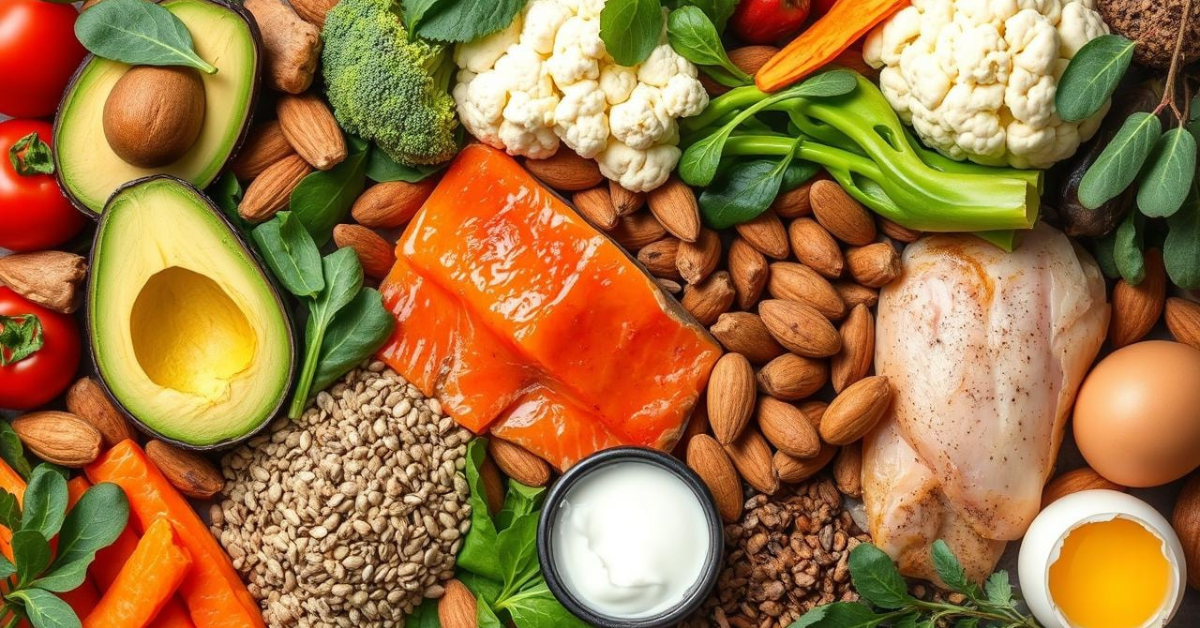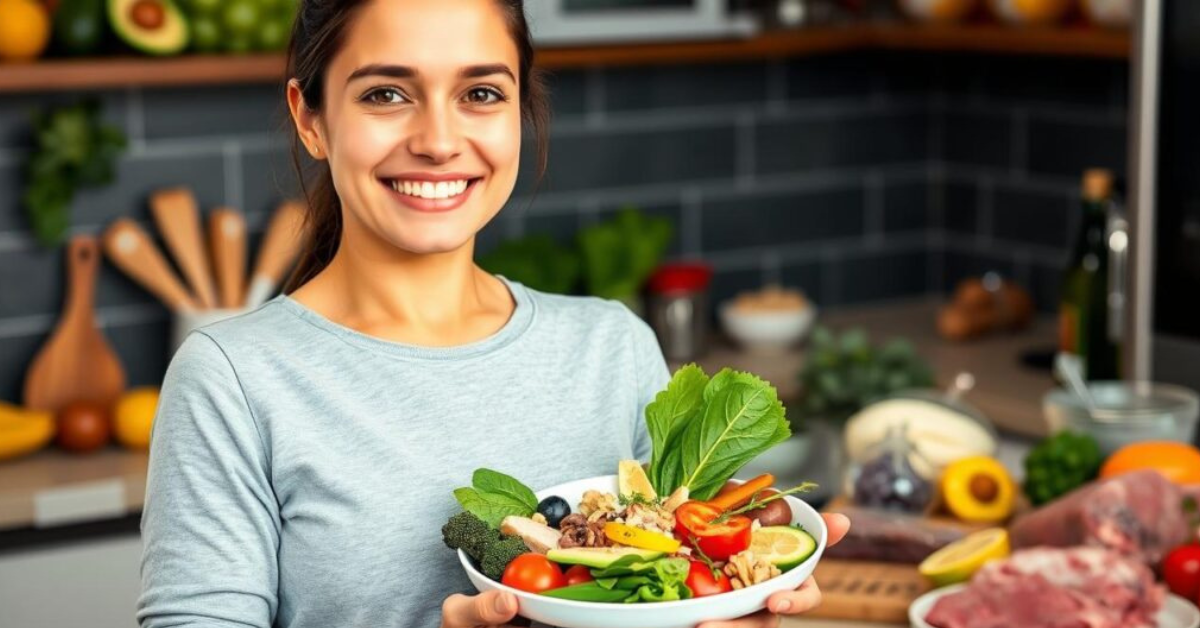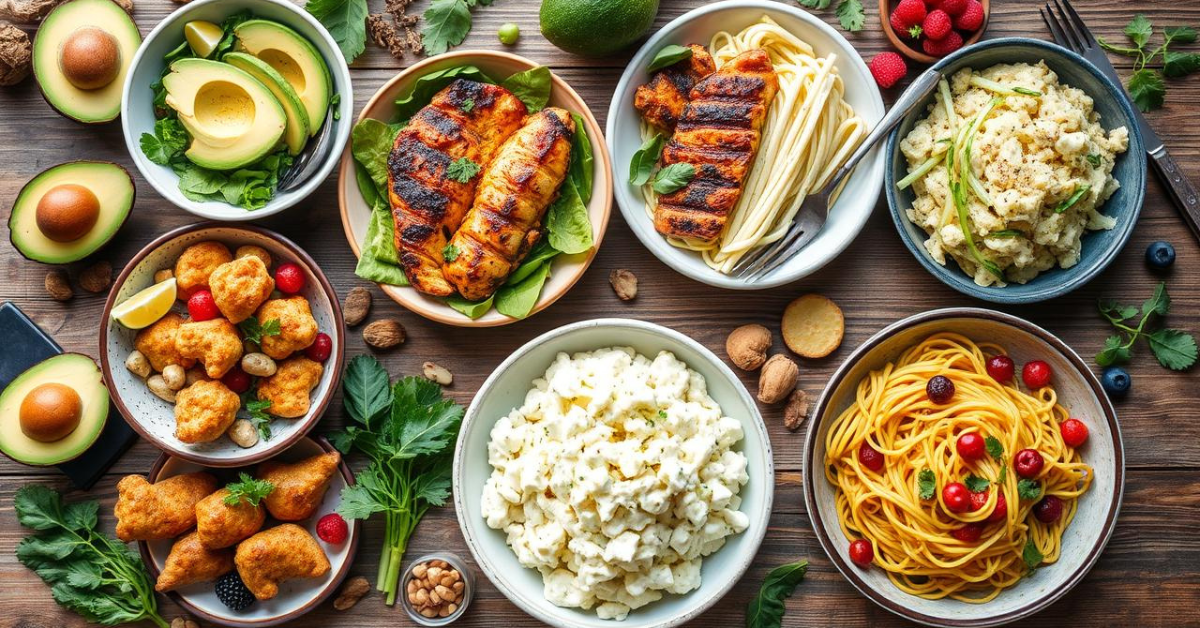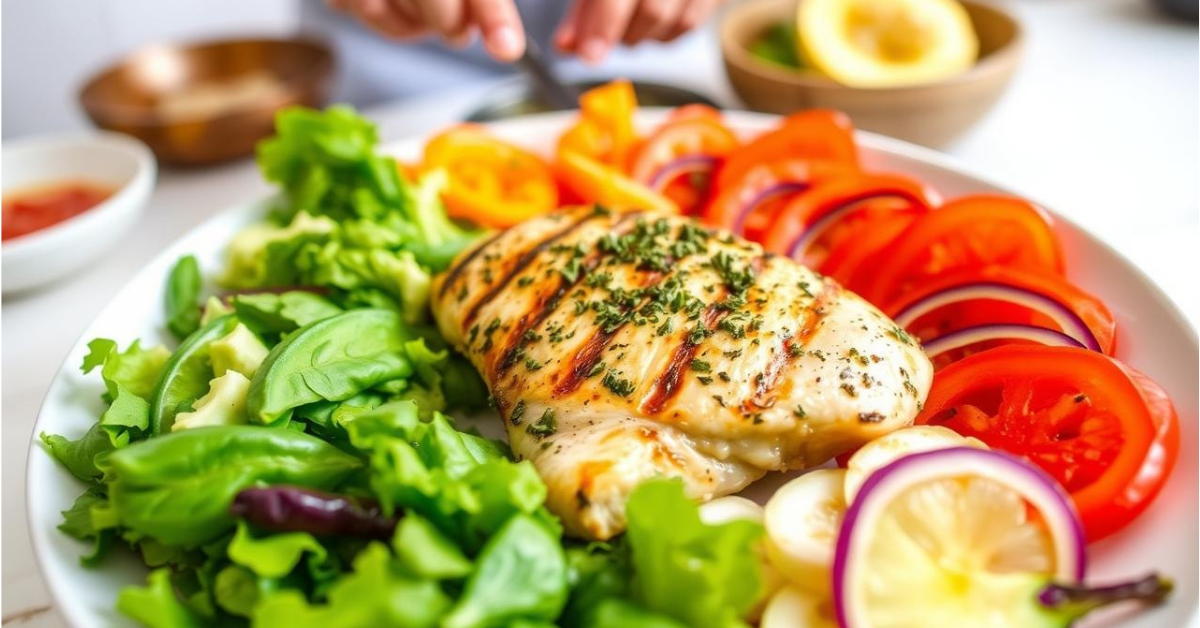Did you know chicken consumption has jumped by over 400% since 1960? This fact might surprise you, especially if you’re on a keto shopping list. Beef is often the top choice for a ketogenic diet because it has more fat than chicken, fish, and most pork cuts.
Having a detailed keto diet shopping list is key to doing well on this plan. It helps you easily switch to a keto lifestyle and enjoy tasty, nutritious meals. Plus, it keeps your carb intake low.
A good keto shopping list includes must-haves like butter, coconut oil, avocados, and low-carb nuts. Heavy cream, cheese, and fatty meats are also important. These items form the base for meals that fit the diet’s fat-heavy requirements. With these items, making quick and easy keto meals is a breeze.
Key Takeaways
- Beef is preferred over chicken for its higher fat content on keto
- A comprehensive keto shopping list is crucial for diet success
- Essential items include butter, coconut oil, avocados, and fatty meats
- Low-carb vegetables and berries are important for nutrient balance
- Stocking up on keto-friendly foods enables quick and easy meal preparation
Introduction to Keto Diet Basics
The ketogenic diet is a low-carb high-fat diet that has gained popularity for its potential benefits in weight loss and health improvement. This keto beginners guide will help you understand the basics of this unique eating plan.
On a ketogenic diet, your daily calorie intake typically consists of 70-75% fat, 20-25% protein, and only 5-10% carbohydrates. For a 2,000-calorie diet, this translates to about 167 grams of fat, 100 grams of protein, and a mere 25 grams of carbs.
The goal of this low-carb high-fat diet is to put your body in a state called ketosis. In this state, your body burns fat for fuel instead of carbohydrates. This metabolic shift can lead to significant weight loss and improved energy levels.
A 2020 review from Cureus found that people following the ketogenic diet experienced weight loss and improvements in blood pressure, triglycerides, and HDL cholesterol levels within the first 12 months.
Originally developed to treat epilepsy, the keto diet has shown promise in managing other health conditions. A 2019 study in the International Journal of Molecular Sciences suggests that a ketogenic diet may improve cognitive function in patients with Alzheimer’s.
As you embark on your keto journey, remember that proper hydration is crucial. Water should be your primary beverage. For snacks, opt for keto-friendly options like almonds, cheddar cheese, or avocado stuffed with chicken salad.
Understanding Macronutrients on Keto
Keto macros are key to this diet. They help you balance fat, protein, and carbs for ketosis. Let’s look at each macronutrient’s role in the keto diet.
Ideal Fat Intake
Fat is the main focus of a keto diet. Aim for 70-80% of your calories from fat. This high fat intake makes your body use fat for energy instead of glucose.
Choose healthy fats like avocado oil, MCT oil, and lard. These fats have no carbs and help you stay in ketosis.
Protein Requirements
Protein on keto should be moderate, making up 20-30% of your calories. This helps keep your muscles strong without stopping ketosis. If you’re not active, aim for 0.8g of protein per pound of lean body mass.
If you’re active, you might need up to 1.2g per pound. Protein is 46% ketogenic and 58% anti-ketogenic, so it’s important to balance it right.
Carbohydrate Limits
Carbs on keto should be very low, making up 5-10% of your calories or 20-50 grams a day. Keeping carbs low is key for ketosis. Eat low-carb veggies like cauliflower and spinach.
Some fruits that work on keto include avocados and blackberries. By following these keto macros, you’ll be on your way to ketosis. Choose nutrient-dense foods to get vitamins and minerals while keeping carbs low.
Essential Keto-Friendly Proteins
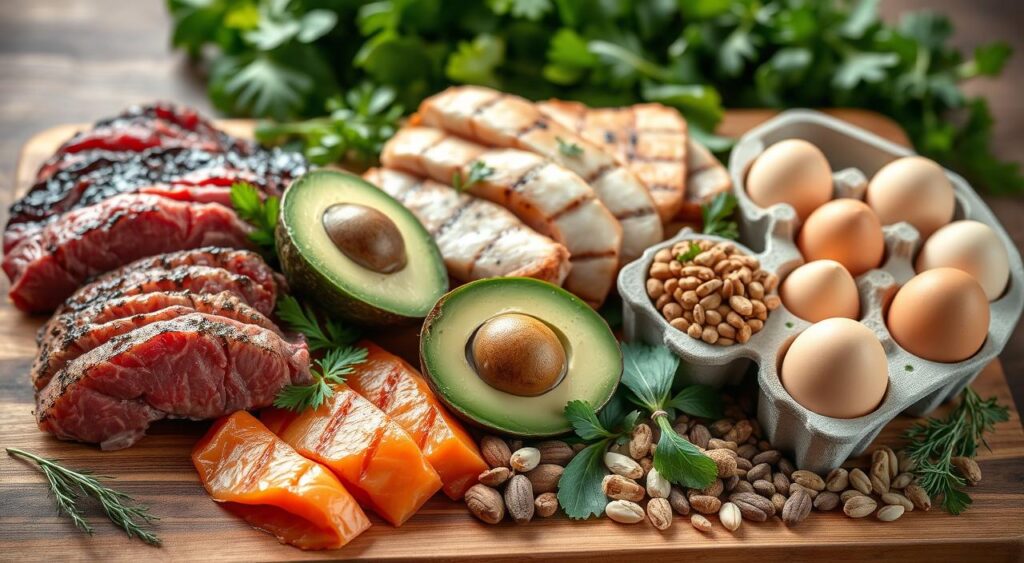
Keto proteins are key for keeping muscle mass up and feeling full on a ketogenic diet. A good keto shopping list should have many high-protein foods. These help meet your nutritional needs.
Meat and Poultry Options
Keto-friendly meats are important for a low-carb lifestyle. Choose grass-fed beef, chicken, pork, and game meats like elk and venison. These meats are high in protein and low in carbs.
Fish and Seafood Choices
Fatty fish are great for keto diets because they’re full of omega-3 fatty acids. Salmon, mackerel, and sardines are top seafood picks. Add lower-fat seafood like lobster and shrimp for more variety.
Eggs and Dairy Products
Eggs are a flexible keto protein source that fits into any meal. Full-fat dairy items like cheese, heavy cream, and yogurt give you protein and fat. This meets keto diet goals.
- Choose dark meat chicken for higher fat content
- Opt for wild-caught fish when possible
- Include a variety of cheeses for flavor and nutrition
When picking proteins for your keto diet, go for those with more fat. This helps keep the right balance of macronutrients. Adding these keto-friendly proteins to your meals keeps you satisfied and on target with your diet.
Low-Carb Vegetables for Keto
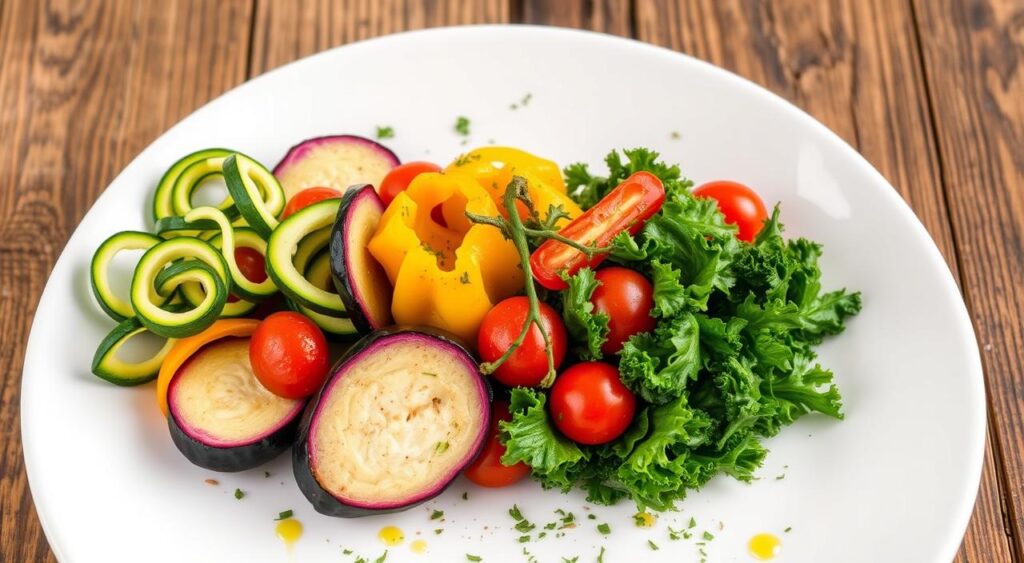
Keto vegetables are key for a balanced low-carb diet. They are packed with vitamins and minerals and keep carbs low. Leafy greens like spinach, kale, and lettuce are great for keto diets. A 100-gram serving of spinach has only 0.8g net carbs, perfect for a ketogenic lifestyle.
Other low-carb veggies you should add to your meals are:
- Asparagus (2g net carbs per 100g)
- Bell peppers (3g net carbs per 100g)
- Broccoli (4g net carbs per 100g)
- Cauliflower (3g net carbs per 100g)
- Zucchini (2g net carbs per 100g)
These keto veggies help you stay in ketosis and make meals more interesting. For example, cauliflower can be used instead of rice or mashed potatoes. Zucchini noodles, or “zoodles,” are a tasty pasta substitute.
It’s important to limit starchy veggies like potatoes and carrots when eating keto. Instead, choose colorful, fibrous options for a wide range of nutrients. By picking the right keto vegetables, you can enjoy tasty meals and stay within your daily carb limit of 20-50g net carbs.
Keto Shopping List: Healthy Fats and Oils
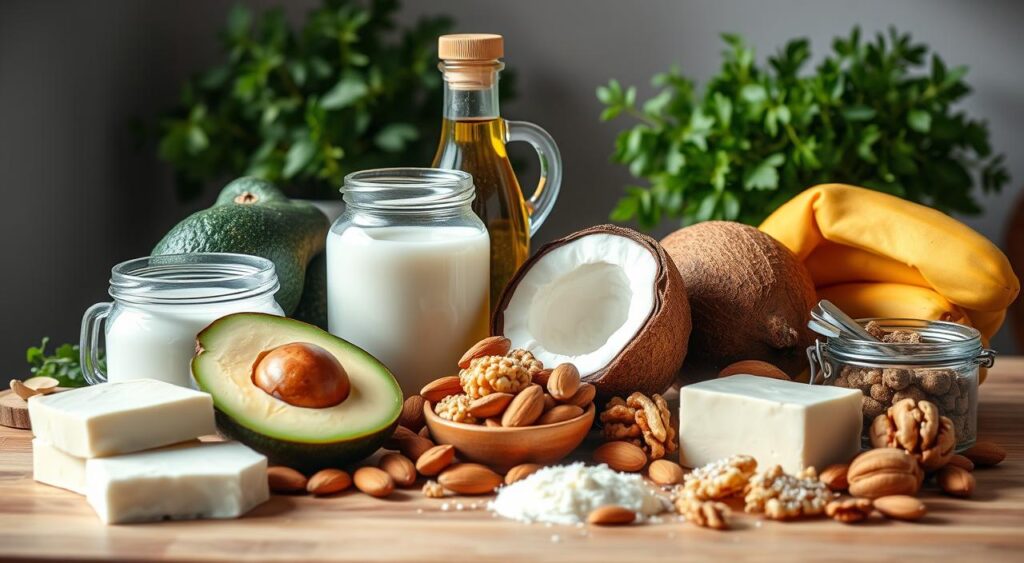
Healthy fats are key for a keto diet. They help you stay in ketosis and give you energy. Let’s look at the main fats you should add to your keto shopping list.
Cooking Oils
Keto oils are crucial for cooking. Choose avocado oil, coconut oil, and olive oil. These oils are full of healthy fats and can handle high heat. MCT oil is also great, often added to drinks for a quick energy boost.
Nuts and Seeds
Nuts and seeds are packed with healthy fats and fiber. Almonds, macadamia nuts, and walnuts are excellent choices. Chia seeds and flax seeds are low in carbs but high in fiber, making them great for many recipes. Pistachios provide a good mix of healthy fats and protein.
Avocados and Olives
Avocados are a top pick for the keto diet, full of monounsaturated fats and fiber. They’re versatile and fit into many dishes. Olives are also a great source of healthy fats, loaded with antioxidants. Both avocados and olives are packed with nutrients and keep you feeling full.
Remember, the keto diet aims for no more than 50 grams of carbs daily. By focusing on these healthy fats, you’ll support ketosis and reach your diet goals.
Keto-Approved Pantry Staples

Having keto pantry staples is crucial for a low-carb lifestyle. These items make cooking easier and keep you ready for keto meals. They’re a must for anyone on a keto diet.
Keto-friendly flours are essential for baking. Almond flour and coconut flour are top picks. They work well in many recipes, like bread and pancakes. If you’re allergic to nuts, sunflower seed meal is a good choice.
Low-carb condiments bring flavor without the carbs. Search for sugar-free ketchup, BBQ sauce, and mayonnaise. Mustard and hot sauce are usually keto-safe. Coconut aminos can also replace soy sauce in recipes.
Don’t overlook sweeteners. Erythritol, monk fruit, and stevia are great sugar substitutes. They let you enjoy sweets without ruining your diet. Keto-friendly chocolate chips are perfect for satisfying your sweet tooth.
- Proteins: Canned fish, bone broth, and collagen powder
- Fats: Coconut oil, avocado oil, and nut butters
- Extras: Unsweetened cocoa powder, baking powder, and xanthan gum
With these keto pantry staples, making delicious, low-carb meals is easy. Always check labels for hidden carbs and pick products made for a ketogenic diet.
Quick and Easy Keto Meal Ideas
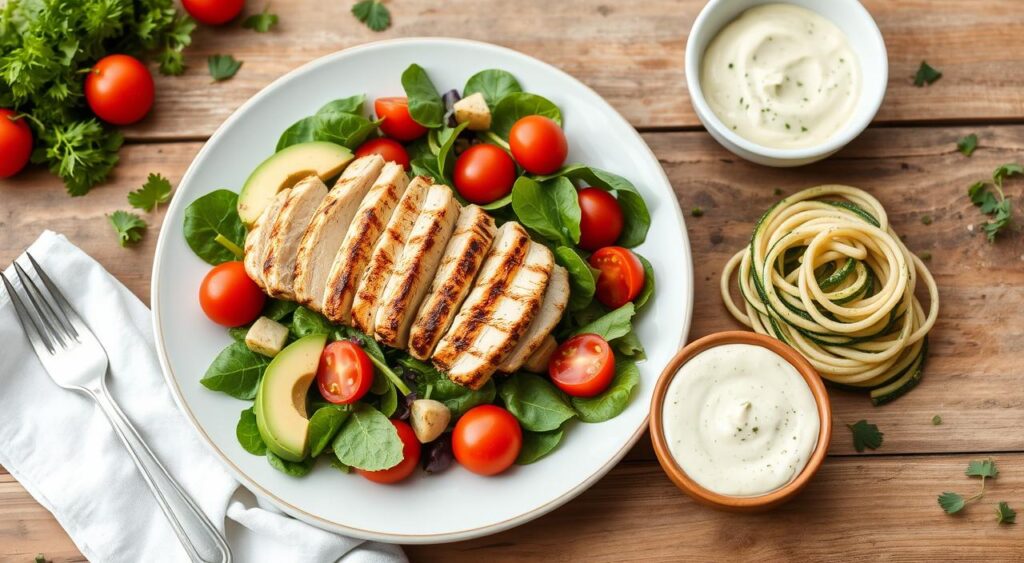
Keto recipes don’t have to be hard. With the right ingredients, you can make quick keto meals that help you stay on track. Let’s look at some tasty options for every part of your day.
Breakfast Options
Start your morning with protein-packed breakfasts. Sausage Egg and Cheese Bites are great for busy mornings, with less than one net carb per bite. For a refreshing drink, try a Keto Coffee Frappuccino, which has under 2 net carbs per serving.
Lunch and Dinner Recipes
For lunch and dinner, keto recipes offer a lot of variety. The One Pan Cheesy Jalapeño Chicken serves 4 and has only 5 net carbs. If you’re in the mood for comfort food, try the hearty keto chili recipe. It serves 8 with 8.5 net carbs per serving.
Snack Suggestions
Easy keto snacks keep hunger at bay between meals. Bacon Keto Biscuits are a savory treat with just 2.1 net carbs each. For a cheesy delight, try Cheesy Keto Breadsticks, yielding 12 breadsticks with 1.9 net carbs each. Pizza lovers can enjoy Pizza Chaffles, with each mini pizza containing only 1.8 net carbs.
These quick keto meals and snacks show that keeping a keto lifestyle can be both delicious and easy. With a variety of options for every meal, you’ll never lack tasty ideas to keep your diet interesting and satisfying.
Tips for Successful Keto Grocery Shopping
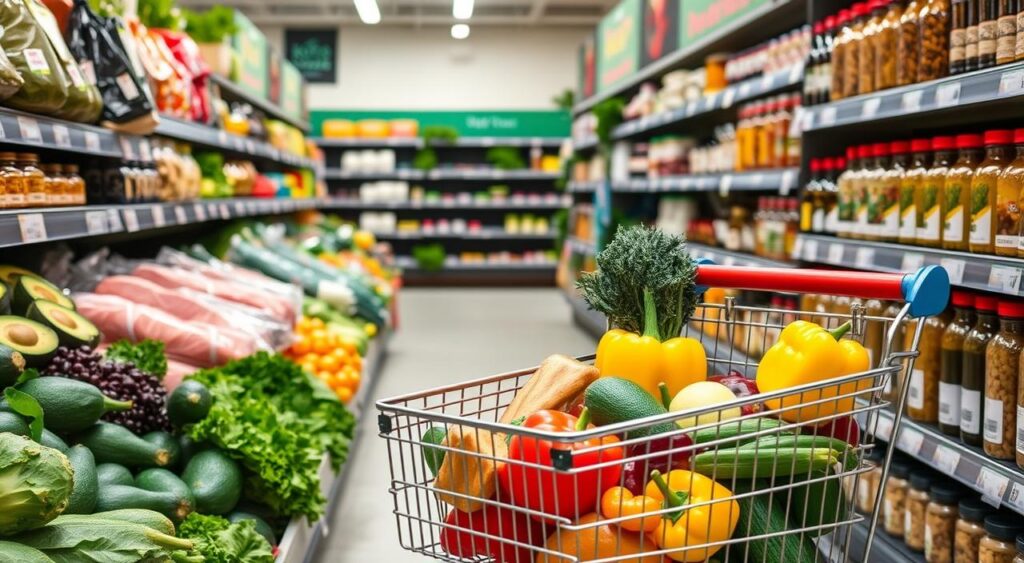
Mastering keto shopping tips can make your diet journey smoother. Start by creating a well-planned list focusing on keto friendly foods. This approach saves time and keeps you on track with your low-carb goals.
When it comes to grocery store navigation, stick to the perimeter. Fresh produce, meats, and dairy are usually located here. These areas are great for keto dieters. Avoid the middle aisles where processed foods lurk.
Reading food labels is crucial for keto success. Pay close attention to net carbs and hidden sugars. Opt for full-fat dairy over low-fat versions. Look for sugar-free condiments and sauces to add flavor without carbs.
Consider buying in bulk for keto staples like nuts and oils. This can save money in the long run. Planning meals and shopping smartly can help you stick to a keto diet on a budget.
- Choose fatty cuts of meat for higher fat content
- Pick low-carb vegetables like spinach and broccoli
- Select full-fat cheese varieties
- Grab eggs for versatile meal options
Don’t shy away from trying new keto-friendly foods. Variety keeps your diet interesting and sustainable. With these tips, you’ll navigate the grocery store like a keto pro, making your shopping trips efficient and effective.
Conclusion
Starting a keto lifestyle means planning and making a good shopping list. You need to focus on high-quality fats, moderate protein, and low-carb veggies. This way, you can make tasty meals and stay in ketosis. The key is to get about 80% of your calories from fat, 15-20% from protein, and less than 5% from carbs.
A good keto diet includes lots of nutrient-rich foods. Healthy fats like avocados, olive oil, and fatty fish give you omega-3 fatty acids. Non-starchy veggies are packed with vitamins, minerals, and fiber, keeping carbs low. Protein sources such as meat, poultry, and eggs give you B vitamins, zinc, and selenium. Adding full-fat dairy, nuts, and seeds helps meet your daily nutritional needs.
For lasting keto success, always check food labels for hidden carbs and plan your meals ahead. Eating whole, unprocessed foods is key to a nutrient-rich diet. With over 100 keto-friendly foods to pick from and a daily carb limit of about 25g, the keto diet is flexible and can be good for your health. Research shows it can lead to weight loss and help with type 2 diabetes and some cancers. By sticking to these tips, you can make a keto diet that supports your health goals.
FAQ
What are the essential items to include in a keto shopping list?
For a keto shopping list, include high-fat foods like butter, coconut oil, and avocados. Also, add low-carb nuts, heavy cream, and cheese. Don’t forget protein sources such as beef, chicken, and fatty fish.
Also, include eggs, almond butter, and some low-carb fruits like blackberries and raspberries. Low-carb veggies like leafy greens and zucchini are also key.
What are the macronutrient ratios for a ketogenic diet?
A ketogenic diet focuses on 70-80% fat, 10-20% protein, and 5-10% carbohydrates. For a 2,000-calorie diet, aim for 167 grams of fat, 100 grams of protein, and 25 grams of carbs.
What are some keto-friendly protein sources?
Great keto proteins are chicken (especially dark meat), beef (grass-fed), and pork. Fatty fish like salmon and mackerel are also good. Eggs and full-fat dairy products like cheese and heavy cream are excellent choices.
Which vegetables are low-carb and suitable for a keto diet?
Top low-carb veggies for keto include leafy greens like spinach and kale. Also, asparagus, bell peppers, broccoli, cauliflower, cucumbers, zucchini, and mushrooms are great.
What are some healthy fat sources on a ketogenic diet?
Healthy fats for keto include coconut oil, olive oil, and avocado oil. MCT oil, nuts and seeds like almonds, and avocados are also good choices. Olives are another great option.
What are some keto-approved pantry staples?
For keto, stock up on almond flour and coconut flour for baking. Sugar substitutes like erythritol and stevia are also good. Don’t forget unsweetened cocoa powder, sugar-free chocolate chips, and mayonnaise.
Mustard, hot sauce, herbs, spices, bone broth, canned fish, and sugar-free nut butter are also essentials.
What are some quick and easy keto meal ideas?
Quick keto meals can be egg-based, like omelets or frittatas. Or, try protein with low-carb veggies, such as grilled chicken with broccoli. One-pan meals like egg roll in a bowl or creamy garlic mushroom chicken are also great.
Snacks can be cheese, nuts, hard-boiled eggs, or keto-friendly fat bombs.
What are some tips for successful keto grocery shopping?
When shopping for keto, focus on the fresh foods at the store’s perimeter. Always check food labels for net carbs and hidden sugars. Choose full-fat dairy and sugar-free condiments.
Buying in bulk for staples is smart. And don’t hesitate to try new keto-friendly foods to keep things interesting.



